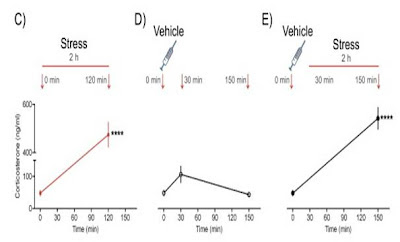.... toward preventing PTSD symptoms.
 |
| Post Traumatic Stress Disorder |
This may surprise you as the S in PTSD stands for STRESS. How on earth could stress prevent it? But you heard correctly. A new paper by
Rao et al., (2012) from Biological Psychiatry shows that a little stress in the form of glucocorticoids, prior to an acute stress event actually prevents PTSD-like symptoms in rats.
First of all how do you tell if a rat has PTSD?
This study uses two measures: one behavioral and one cellular.
To test anxiety in a rat, you can put in on an Elevated Plus Maze (EPM). Rats don't love heights, and they do love dark corners. But, they are also somewhat naturally curious. The EPM makes use of these rat characteristics to test how anxious the rat is.
The EPM has four arms, two are open (but far enough off the ground that the rat can't just step off the maze) and two are enclosed with walls. Normal rats tend to explore all the arms of the maze roughly equally, but anxious rats tend to strongly avoid the open arms. The amount of time spent in the open arm area is a generally accepted measure of how anxious the rat is.
An earlier
paper from the same lab, found that rats who had undergone the single stress event were more anxious (spent less time in the open arms of the EPM) 10 days after the event, but NOT 1 day after the event. The single event stress and the delay of symptom onset are why this study is more relevant for PTSD than for chronic stress.
As interesting as the behavioral experiments are, the cellular level experiments are where it gets really cool (The Cellular Scale is not biased or anything). They used the
Golgi stain to visualize neurons in the
Amygdala. They measured how long the
dendrites were and also how many spines they had on them. (Spines are the little protrusions that come of dendrites to receive
synaptic inputs).
They found that the stressed rats had
more dendritic spines on the amygdala neurons than the non-stressed rats. Not only that, but this increase in spine density was apparent 10 days after the stress event, but not 1 day after.
You might think dendritic spine growth is a good thing, and likely signifies
synaptic plasticity and pathway strengthening... but remember this is the
amygdala, a structure critical for FEAR learning, more spines here may not be beneficial. Stronger pathways to these amygdala neurons likely means that they fire more easily.
Now that we understand how PTSD is measured in a rat, we can move on to how they 'cured' it in this paper. Rao et al found that when they injected
vehicle (a fancy science term for 'nothing' or '
placebo' or 'saline') into the rat 30 minutes before the 2 hour stress event, the rat no longer showed either the increased in anxiety (fewer open arm entries on the EPM) or the increase in dendritic spine density.
Pretty weird, considering they were injecting
vehicle prior to the stress event. How could inactive saline (essentially
nothing) cure PTSD symptoms?
They figured out that the actual injection process was stressing the rat out a little bit. When animals (including humans) are stressed, they release a hormone called
cortisol.
 |
| Rao et al., 2012 Fig 1C,D,E |
They found that the 2 hour stress event caused a huge rise in
corticosterone (right and left panels), while the injection (vehicle) alone caused a small rise (middle panel).
Because they were injecting
nothing, they hypothesized that the corticosterone produced by the small stress of being injected was somehow protecting against the large 2 hour stress event.
The rest of their paper is basically confirming this. They add corticosterone to the water of the rats and this also prevents the PTSD-like symptoms. They find that all their manipulations isolating the corticosterone confirm that this is what is protecting the rats from the delayed impact of the stress event.
Interestingly there is evidence that 'small stress' can help prevent 'big stress' in humans too. They cite clinical studies reporting that intensive care unit (ICU) patients who receive injections of stress-level cortisol during treatment are less likely to develop
ICU-related PTSD symptoms.
It is a puzzling paradox at the moment, but the next step is to figure out
how exactly this little stress can reduce big stress.
Epilogue: I was lucky enough to see Dr. Chattarji, the principle investigator of this study, give a talk at a conference a few months ago. And one interesting piece of information that you can get from a talk, but will never read in a paper is how the scientists originally stumbled upon their finding. In this case, Chattarji's lab didn't start their study by injecting vehicle. They were actually testing a real drug that they thought might help alleviate PTSD. They had a beautiful result showing that when you injected "drug X" before the 2 hour stress event, you eliminated the PTSD symptoms. The natural conclusion is to think that "drug X" is a new cure for PTSD.
But therein lies the importance of the
control group. To control for any effects of simply injecting the rat, they injected vehicle. When they saw that the
vehicle prevented the PTSD symptoms just like the actual drug, they were crushed! This is the ultimate demise of an experiment. The control group shows the same thing as the drug group, which means that
the drug does not work! Luckily they were flexible and smart enough to investigate what they did see, that the injection alone could protect against the PTSD symptoms.
Also, if someone would like to explain the difference between cortisol and corticosterone, please do. I clearly do not have a full understanding here.
©
TheCellularScale Rao RP, Anilkumar S, McEwen BS, & Chattarji S (2012). Glucocorticoids Protect Against the Delayed Behavioral and Cellular Effects of Acute Stress on the Amygdala. Biological psychiatry PMID: 22572034Mitra R, Jadhav S, McEwen BS, Vyas A, & Chattarji S (2005). Stress duration modulates the spatiotemporal patterns of spine formation in the basolateral amygdala. Proceedings of the National Academy of Sciences of the United States of America, 102 (26), 9371-6 PMID: 15967994
Rao RP, Anilkumar S, McEwen BS, & Chattarji S (2012). Glucocorticoids Protect Against the Delayed Behavioral and Cellular Effects of Acute Stress on the Amygdala. Biological psychiatry PMID: 22572034Mitra R, Jadhav S, McEwen BS, Vyas A, & Chattarji S (2005). Stress duration modulates the spatiotemporal patterns of spine formation in the basolateral amygdala. Proceedings of the National Academy of Sciences of the United States of America, 102 (26), 9371-6 PMID: 15967994

























